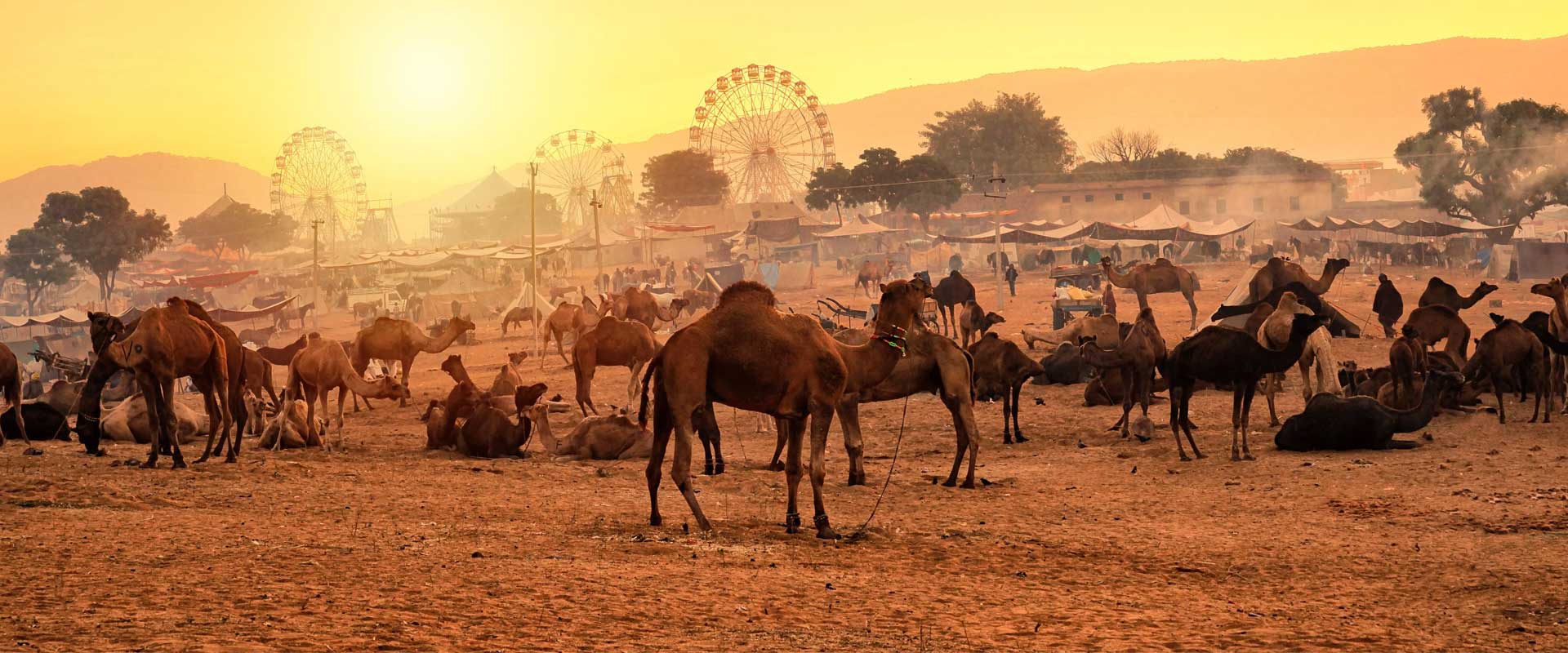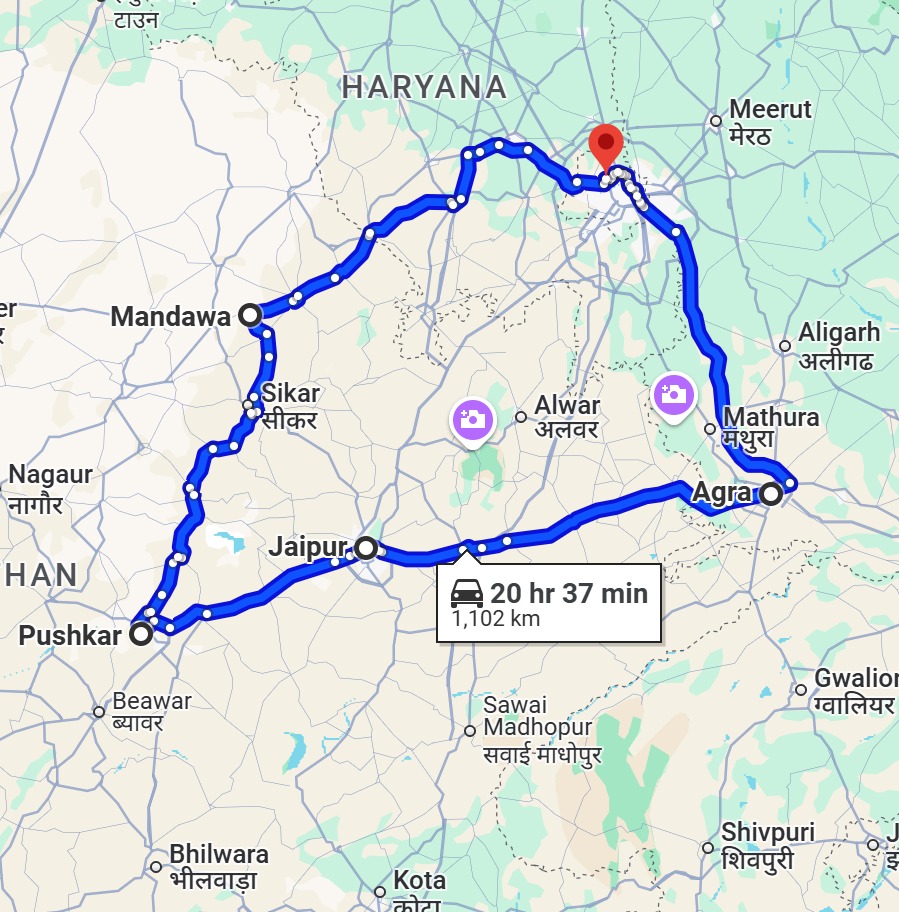- Home
- A&A Tours
- Trip Types
- Tailor Made
- Luxury Train Tour
- Private Jet
- Luxury Hotels
- Luxury Cars
- About Us
- Find My Tour
To More Inquiry


The Pushkar Fair, also called the Pushkar Camel Fair or locally as Kartik Mela or Pushkar ka Mela is an annual multi-day animal fair and cultural fête held in the town of Pushkar. Pushkar Fair has also become a prominent tourist attraction for domestic and international travelers, where our guests can enjoy folk music and dances, magic shows, cultural events and competitions include tug of war between women teams as well as men teams, the “matka phod”, “longest moustache competition”, “bridal competition”, camel races and others activities. Thousands of people travel to the banks of the Pushkar Lake where the festival takes place. Men exchange their livestock, which includes camels, horses, cows, sheep and goats. Peoples enjoy great shopping during the Pushkar Fair. In this fair stalls are put up, which sell tiny souvenirs, embroidered garments, colorful shiny bangles, textiles, jewelry, footwear, leather products, and much more may be obtained from this fair.
Our Guide will meet you when you arrive in Delhi and take you to your hotel. During the Mahabharata, Delhi serves as both the capital of Indraprastha and the Pandavas. This city has been known as the "City of Cities" since it was inhabited in the sixth century BC and served as the capital of numerous different kingdoms. Delhi is a city rich with stunning structures that have been shaped by its various kings and cultures. The Mughal monarchs had an impact on the locals' eating habits, and this area is where Mughal cuisine originated. Delhi celebrates every event since other states are so close.We will go to the Qutub Minar, which is billed as India's largest minaret, by lunchtime. Arrive at Lakshminarayan shrine, a shrine devoted to Lord Narayana and the goddess Lakshmi, after passing the president's residence and other government secretarial structures.
You
will travel by road from Delhi to Mandawa. Named for Rao Shekha, Shekhawati was
established by Shekhawat Rajputs. They constructed around fifty forts and
palaces, one of which is now the Heritages Hotel. The settlement of Shekhawati
was well-known for its Havelis, or homes, which had the most frescoes in the
entire globe. In the 19th century, many Marwari people left their homes to
travel to bigger cities, where they achieved considerable success. The Marwari
family was a prominent business community in this area. To showcase their
success, the Marwari family commissioned artists to paint their houses and
larger homes in these communities. The remainder of the day is spent relaxing.
You have access to transport within the city borders. Spend the night at
Mandawa or one of the Shekhawati villages.
Mandawa,
Nawalgarh, Dundlod, and other Shekhawati villages will be among the places you
visit today. Thakur Nawal Singh established Mandawa in 1755, and it now holds a
collection of armories, antique costumes, an 1820 canon, ancient coins, and
other fascinating artifacts. "The Open Art Gallery" refers to the
villages with exquisite havelis, houses, and frescoes. The artists' paintings
depict mythological gods, goddesses, and animals; many of these lovely havelis
have been converted into elegant hotels. You have access to transport within
the city borders. Spend the night at Mandawa or one of the Shekhawati villages.
You
will be going to Pushkar by road today. You will begin your Pushkar trip at
midday. Considered to be one of India's oldest cities, Pushkar is a highly
revered Hindu pilgrimage site. It is believed that Lord Brahma founded this
holy city just for Hindus. After Vaira Nabha, a demon, killed Brahma's kid,
Brahma smote him with a lotus blossom, killing the demon. On a full moon day,
Brahma offered sacrifices at the lake that was created when the Lotus Patel
fell at Pushkar. There is only one temple in the world that is devoted to
Brahma. Hindus think they will be saved if they take a lake bath. Thousands of
livestock and camels are traded during Pushkar's well-known Camel Fair. You
have access to the transit. (Inside the city).
You
will go to Jaipur, the capital of Rajasthan and also referred to as the Pink
City, in the morning. There is a lot of interesting architecture and design in
this city. Maharaja Jai Singh constructed the city, and it was he who gave
Jaipur its name. You may spend the remainder of the day exploring the bustling,
vibrant streets or going to the Jaipur bazaars. The vibrant bazaars of Jaipur
provide a fantastic opportunity for shopping.
Upon
arrival, the city trip includes a visit to Amer, also known as Amer Palace,
which was Jaipur's former capital. Sukh Niwas, Sheesh Mahal, the Palace of
Mirrors, Diwan-e-Aam, the Hall of Public Audience, and Diwan-e-Khans, the Hall
of Private Audience, are all quite lovely. You will take a tour of the
seven-story Maharaja City Palace in Jaipur, as well as the observatory Jantar
Mantar. It draws astronomers and mathematicians from all over the world.
Another well-liked palace because of its exotic architectural style is the Hawa
Mahal. Both the Jaipur Business Centres and the Pink Rose Gardens will be in
your path. Without shopping in Jaipur, the trip isn't complete. The markets of
Jaipur are well-known for their clothing, carpets, jewelry, and other
handicrafts.
You will pass by Fatehpur Sikri, which was constructed in the sixteenth century by Emperor Akbar, on your way from Jaipur to Agra. He has outstanding records on the Mughal civilization, which is home to numerous historical sites, and is a well-known UNESCO World Heritage site in India. You will have a tour of the five-story Panch Mahal, the magnificently designed Buland Darwaza, and Jama Masjid before continuing on to Salim Chisti. This has a three-arched entrance known locally as Horse Shoe Gate and is situated in the center of the Portico. Other elegant structures, including Ibadat Khana, Mariam-uz-Zamani's palace, Naubat Khana, and Birbal's home, will be toured. You will be taken to Agra to spend the night after that.
Agra,
a city near the Yamuna River, was formerly the capital of Hindustan. Agra, also
known as Akbarabad, saw its peak during the Mughal era and served as the
capital of Akbar, Jahangir, and Shahjehan. One of the world's wonders, the Taj
Mahal, will be visited at the start of the day trip to Agra. Between 1631 and
1648, the Mughal Emperor Shah Jahan meticulously constructed this magnificent
structure out of white marble in remembrance of his most beloved Queen, Mumtaz
Mahal.Your next destination is Agra Fort, a UNESCO World Heritage site renowned
for its architectural design constructed during the Mughal Empire in the
sixteenth century. It includes a few fantastical tales of royal residences,
such as Jahangir Palace and Khas Mahal. Agra is renowned for its meticulous
marble, wood, and metal work as well as its trimmed marble work.
As
the tour comes to a conclusion, you will be driven from Agra to the airport in
Delhi. No lodging is offered in Delhi because the majority of flights leave
after midnight.


Immerse yourself in the grandeur of luxury at our exquisite palaces, hotels, resorts and safaris.
1 night, 2 adults
$ 14801 night, 2 adults
$ 9901 night, 2 adults
$ 21201 night, 2 adults
$ 9501 night, 2 adults
$ 8001 night, 2 adults
$ 9001 night, 2 adults
$ 8001 night, 2 adults
$ 7501 night, 2 adults
$ 6001 night, 2 adults
$ 7801 night, 2 adults
$ 7001 night, 2 adults
$ 4001 night, 2 adults
$ 5001 night, 2 adults
$ 3501 night, 2 adults
$ 4101 night, 2 adults
$ 4301 night, 2 adults
$ 340